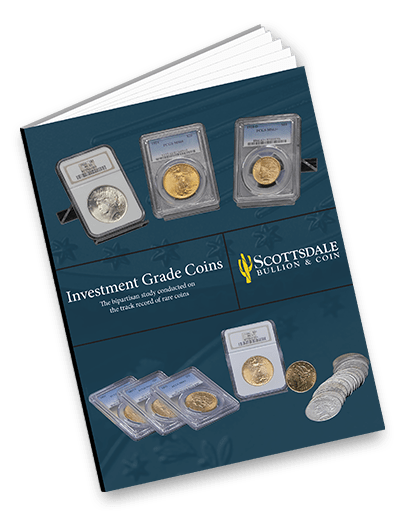In this week’s The Gold Spot video, we discussed the differences between the bullion and investment grade coin markets. Elucidating those discrepancies is essential to understanding the performance of gold and making sound precious metal investments.
The Gold Spot Overtime video above dives deeper into the specific price action of bullion and investment grade coin markets to give investors a clearer picture into how each market is influenced by gold spot prices, supply, and demand and which option may be best for your investment goals.
Explaining the Bullion Market’s Swings
The rapid price action of gold following the initial onset of the pandemic was a perfect illustration of what people do when they get nervous: they panic. People immediately flooded into precious metals to preserve their wealth which catapulted gold prices from the $1,400 level to a top of $2,069/oz.
As with all major movements in the market, this massive jump was eventually subject to some corrections. The market experienced some potentially manipulative ETF trading, and institutional investors started moving money back and forth between bullion markets and the DOW in an attempt to optimize gains.
Eventually, the price of gold bullion bottomed out at $1,685/oz. This is the point analysts are now looking at to predict where gold prices might settle after the current correction. The bullion market’s previous high was set on March 8, 2022, at around $2,043/oz.
Recently, gold prices bounced off the 2-year resistance point at around $1,695/oz. The value of gold has been on an upward trend since touching that relative bottom, making it a great time for bullion investors who purchased in 2020 or at higher prices to dollar-cost average into this precious metal to average out their cost. Look for more details on how to do this in next week’s The Gold Spot Overtime video.
The investment grade coin market has performed in alignment with our expectations. To everyone’s delight, this market hasn’t experienced the same undulations as its bullion counterpart which is one of the biggest advantages to investing in coinage.
The MS63 1904 $20 Liberty gold coin is a common standard used to demonstrate the value of the overall gold coin market due to its popularity among numismatic investors. At the beginning of lockdown, the Liberty coin gained an impressive amount of value. It went from being a $1,600 coin to worth $2,700 in just a few months. The steep rise in value lasted a bit longer than the bullion spike but eventually found the correction too.
The main difference is that the retraction in the investment grade market wasn’t nearly as severe or volatile as the dip experienced in bullion. Instead of hitting repeated peaks and valleys, the investment grade coin market hit more of a price plateau owing to its relative stability.
When inflation started to hit in November, the MS63 1904 $20 Liberty Coin steadily outgrew the horizontal trend. The entire investment grade market has been on an uptrend ever since as inflation spirals out of control. Currently, the value of the Liberty Coin is sitting at around $2,750/oz., and there’s still plenty of room to grow.
Understanding the Coin Market’s Stability
There’s no end in sight to the market’s poor performance. Every bit inflation creeps higher, the value of gold is given more room for upward growth. It’s only a matter of time before the effects of inflation are reflected in the prices of gold in both bullion and investment grade coin markets.
As an investor, it’s important to find the market and investment strategy that works best for you. Feel free to get in touch with the precious metals advisors at Scottsdale Bullion & Coin to learn more about these different markets and which might be best for your investment goals.
Make sure to tune in next week for another installment of The Gold Spot Overtime where we’ll discuss the dollar-cost averaging investment strategy and how to use it to your advantage.
UPDATE: The Gold Spot Overtime is Live. Watch it here!



